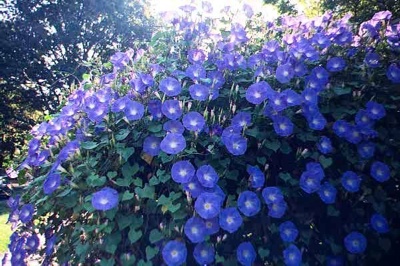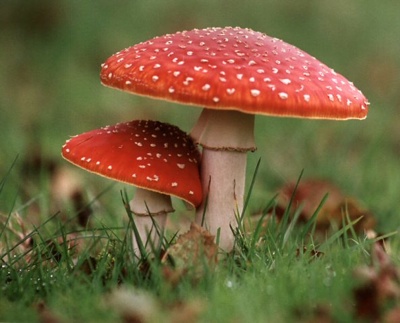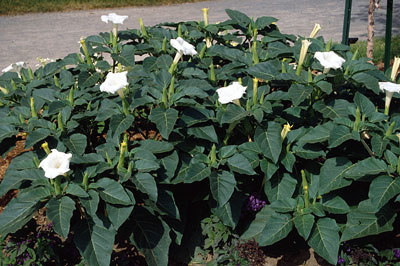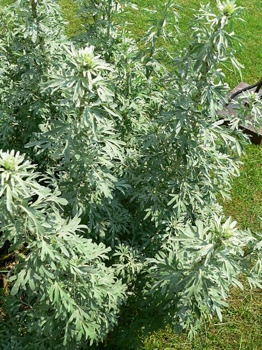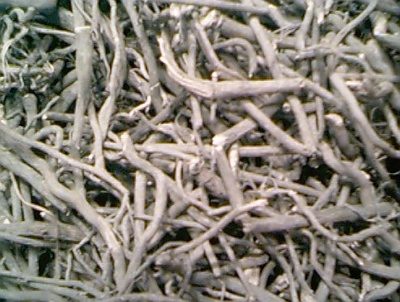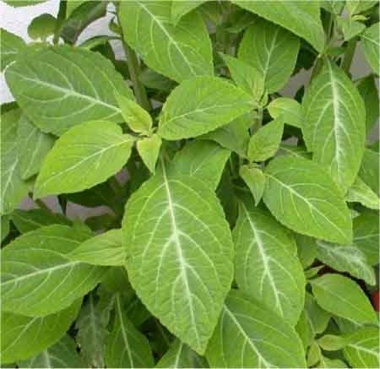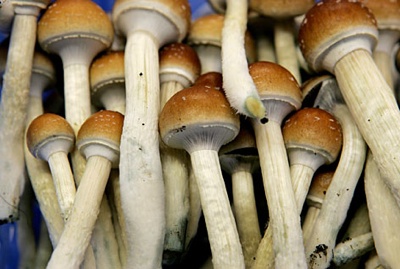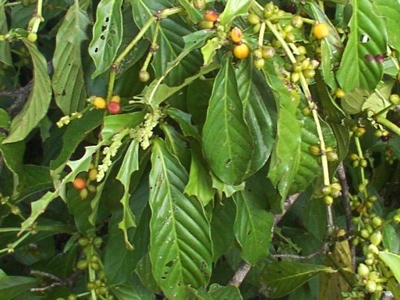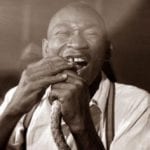If you have had any experiences with the following plants, be sure to tell us about it in the comments – we are always interested in hearing about our readers experiences in areas like this. So, onward, the list:
Active Constituents: Ergoline alkaloids This is a species of morning glory native to the New World tropics, and widely cultivated and naturalized elsewhere. The seeds have been used for centuries by many Mexican Native American cultures as an hallucinogen; they were known to the Aztecs as ‘tlitliltzin’, the Nahuatl word for “black”. Their traditional use by Mexican Native Americans was first discovered in 1941, brought to light in a report documenting use going back to Aztec times. It was reported in 1960 that the seeds of Ipomoea tricolor were used as sacraments by certain Zapotecs, sometimes in conjunction with the seeds of Rivea corymbosa, another species which has a similar chemical composition. Hallucinations are the predominant effect after ingesting morning glory seeds. Vivid visual and tactile hallucinations, as well as increased awareness of colors have been described.
Active Constituents: Ibotenic acid The quintessential image of an hallucinogenic ‘toadstool’, with it’s red cap and white spots. This fungus is native to birch, pine, spruce, fir and cedar woodlands throughout the temperate and boreal regions of the Northern Hemisphere. These mushrooms were widely used as a hallucinogenic drug by many of the indigenous peoples of Siberia. In western Siberia, the use of A. muscaria was restricted to shamans, who used it as an alternate method of achieving a trance state. In the east, A. muscaria was used by both shamans and common people alike, recreationally as well as religiously. Unlike the hallucinogenic mushrooms of the Psilocybe, Amanita muscaria has been rarely consumed recreationally in modern times. Depending on habitat and the amount ingested per body weight, effects can range from nausea and twitching to drowsiness, auditory and visual distortions, mood changes, euphoria, relaxation, and loss of equilibrium. Amnesia frequently results following recovery.
Active Constituents: Atropine, hyoscyamine and scopolamine Native to either India or Central America, it was used as a mystical sacrament in both possible places of origin. The Native Americans have used this plant in sacred ceremonies. The sadhus of Hinduism also used it as a spiritual tool, smoked with cannabis in traditional pipes. In the United States it is called Jimson Weed, Hell’s Bells (based on the flowers’ shape) or Jamestown Weed. It got this name from the town of Jamestown, Virginia, where British soldiers were secretly (or accidentally) drugged with it, while attempting to suppress Bacon’s Rebellion. They spent several days generally appearing to have gone insane, and failed at their mission. The effects have been described as a living dream: consciousness falls in and out, people who don’t exist or are miles away are conversed with, etc, and the effects can last for days. It may be described as a “real” trance when a user under the effect can be awake but completely disconnected from his immediate environment.
Active Constituents: Thujone Native to temperate regions of Europe, Asia and northern Africa, the religious association with this plant began with its strong association with the Ancient Greek moon goddess Artemis. In Hellenistic culture, Artemis was a goddess of the hunt, and protector of the forest and children. It is perhaps more famously known as the key ingredient in Absinthe, the favorite drink of 19th Century Bohemian artists. The most commonly reported Absinthe experience is a ‘clear-headed’ feeling of inebriation — a form of ‘lucid drunkenness’.
Active Constituents: Kavalactones An ancient crop of the western Pacific. The word ‘kava’ is used to refer both to the plant and the beverage produced from it. Kava is used for medicinal, religious, political, cultural and social purposes throughout the Pacific. These cultures have a great respect for the plant and place a high importance on it. The drink is used to this day at social gatherings to relax after work, though it has great religious significance, and is used to obtain inspiration. The effects of the drink (it is also occasionally chewed), in order of appearance, are slight tongue and lip numbing; mildly talkative and sociable behavior, clear thinking, calming effects, relaxed muscles, and a very euphoric sense of well-being.
Active Constituents: Diterpenoid known as “Salvinorin A” Salvia divinorum is native to certain areas in the Sierra Mazateca of Oaxaca, Mexico, where it is still used by the Mazatec Indians, primarily to facilitate shamanic visions in the context of curing or divination. Shamans crush the leaves to extract leaf juices; they usually mix these juices with water to create an infusion or ‘tea’ which they drink to induce visions in ritual healing ceremonies. Salvia can be chewed, smoked, or taken as a tincture to produce experiences ranging from uncontrollable laughter to much more intense and profoundly altered states. The duration when smoked is much shorter than for some other more well-known psychedelics, and Salvia typically last for only a few minutes. The most commonly reported after-effects include an increased feeling of insight and improved mood, and a sense of calmness and increased sense of connection with nature.
Active Constituents: Psilocybin and psilocin Psilocybin mushrooms have been part of human culture as far back as the earliest recorded history. Ancient paintings of ‘mushroomed’ humanoids dating to 5,000 B.C. have been found in caves of Northern Algeria. Central and Southern America cultures built temples to mushroom gods and carved “mushroom stones”, dated to as early as 1000-500 B.C. Psilocybian mushrooms were used in ritual and ceremony among the Aztecs, served with honey or chocolate at some of their holiest events. The experience of ingestion is typically inwardly oriented, with strong visual and auditory components. Visions and revelations may be experienced, and the effect can range from exhilarating to distressing.
Active Constituents: Phenethylamine alkaloids, principally Mescaline From early records (specimens from Texas have dated from 3780 to 3660 BC), peyote has been used by indigenous peoples, such as the Huichol of northern Mexico and by various Native American tribal groups, native to or relocated to the Southern Plains States of Oklahoma and Texas. Peyote and its associated religion, however, are fairly recent in terms of usage and practice among tribes in the Southwestern United States; Their acquisition of the peyote religion and use of peyote can be firmly dated to the early 20th Century. Typically consumed as a tea, the effects last about 10 to 12 hours. When combined with appropriate setting, peyote is reported to trigger states of deep introspection and insight, described as being of a metaphysical or spiritual nature. At times, these can be accompanied by rich visual or auditory effects.
Active Constituents: Beta-carboline harmala alkaloids, MAOIs and DMT (dimethyltryptamine)
Active Constituents: THC (tetrahydrocannabinol) The cannabis plant has an ancient history of ritual usage as a trance-inducing drug and is found in pharmacological cults around the world. In India, it has been engaged by itinerant sadhus (ascetics) for centuries, and in modern times the Rastafari movement has embraced it. Some historians and etymologists have claimed that cannabis was used as a religious sacrament by ancient Jews, early Christians, and Muslims of the Sufi order. Elders of the modern religious movement known as the Ethiopian Zion Coptic Church consider cannabis to be the Eucharist, claiming it as an oral tradition from Ethiopia dating back to the time of Christ. Cannabis plants produce a group of chemicals called cannabinoids which produce mental and physical effects when consumed. As a drug it usually comes in the form of dried buds or flowers (marijuana), resin (hashish), or various extracts collectively known as hashish oil. The psychoactive effects of cannabis, are subjective and can vary based on the individual. Some effects may include a general change in consciousness (altered perception), mild euphoria, feelings of well-being, relaxation or stress reduction, lethargy, joviality, enhanced recollection of episodic memory, increased sensuality, increased awareness of sensation, and occasionally paranoia, agitation or anxiety. Contributor: B.C.
